|
|
|
Sort Order |
|
|
|
Items / Page
|
|
|
|
|
|
|
| Srl | Item |
| 1 |
ID:
115287
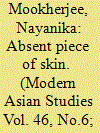

|
|
|
|
|
| Publication |
2012.
|
| Summary/Abstract |
This paper addresses how the wombs of women and the absent skin on the circumcised penises of men become the predominant sites on which racialized and gendered discourses operating during the Bangladesh War are inscribed. This is explored by examining instances of sexual violence by Pakistani soldiers and their local Bengali collaborators. The prevalence of these discourses in colonial documents about the Bengali Muslims underscores the role of history, the politics of identity and in the process, establishes its link with the rapes of Bangladeshi women and men. Through this, the relationship between sexual violence and historical contexts is highlighted. I locate the accounts of male violations by the West Pakistani army within the historical and colonial discourses relating to the construction of the Bengali Muslim and its intertextual, contemporary citational references in photographs and interviews.
I draw on Judith Butler's and Marilyn Strathern's work on gendering and performativity to address the citational role of various practices of discourses of gender and race within colonial documents and its application in a newer context of colonization and sexual violence of women and men during wars. The role of photographs and image-making is intrinsic to these practices. The open semiotic of the photographs allows an exploration of the territorial identities within these images and leads to traces of the silence relating to male violations. Through an examination of the silence surrounding male sexual violence vis-à-vis the emphasis on the rape of women in independent Bangladesh, it is argued that these racialized and gendered discourses are intricately associated to the link between sexuality and the state in relation to masculinity.
|
|
|
|
|
|
|
|
|
|
|
|
|
|
|
|
| 2 |
ID:
146768
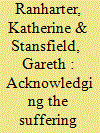

|
|
|
|
|
| Summary/Abstract |
The Iraqi High Tribunal (IHT), as a mechanism of transitional justice, took upon it a pioneering role within the Middle Eastern Region by prosecuting and convicting several high-ranking members of the former suppressive regime in Iraq. As part of this work, the IHT confronted the widespread impunity for and disregard of gender-based crimes, such as rape and other sexual violence, and took steps towards reforming the sector through its progressive statute and the specific acknowledgment of gender crimes within its judgments. It will be the aim of the following article to extend academic writings on Iraq, the IHT and gender, by providing insights into how the tribunal dealt with the issues of rape and sexual violence, the surrounding circumstances and how successful the IHT's recognition of these crimes proved for transitional justice in Iraq.
|
|
|
|
|
|
|
|
|
|
|
|
|
|
|
|
| 3 |
ID:
095242
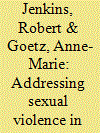

|
|
|
|
|
| Publication |
2010.
|
| Summary/Abstract |
Negotiated peace agreements rarely address the legacy of wartime sexual violence committed by state and non-state armed actors, even in cases where mass rape has been a prominent feature of the conflict. This article examines why this has been the case. It assesses the implications of UN Security Council resolution 1820 (June 2008), which calls for internationally mediated peace talks to address conflict-related sexual violence; advances reasons why doing so may contribute to more durable peace; and outlines where specific textual references to sexual violence in peace agreements could enhance the well-being of survivors and reduce the chances of brutal and widespread sexual violence persisting in the post-conflict period. The article focuses on five types (or elements) of peace agreement: (1) early-stage agreements covering humanitarian access and confidence-building measures; (2) ceasefires and ceasefire monitoring; (3) arrangements for demobilization, disarmament and reintegration (DDR) and longer-term security sector reform (SSR); (4) post-conflict justice institutions; and (5) provisions relating to reparations for victims of serious human rights abuses.
|
|
|
|
|
|
|
|
|
|
|
|
|
|
|
|
| 4 |
ID:
086654
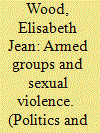

|
|
|
|
|
| Publication |
2009.
|
| Summary/Abstract |
This article explores a particular pattern of wartime violence, the relative absence of sexual violence on the part of many armed groups. This neglected fact has important policy implications: If some groups do not engage in sexual violence, then rape is not inevitable in war as is sometimes claimed, and there are stronger grounds for holding responsible those groups that do engage in sexual violence. After developing a theoretical framework for understanding the observed variation in wartime sexual violence, the article analyzes the puzzling absence of sexual violence on the part of the secessionist Liberation Tigers of Tamil Eelam of Sri Lanka.
|
|
|
|
|
|
|
|
|
|
|
|
|
|
|
|
| 5 |
ID:
140514
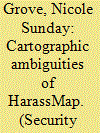

|
|
|
|
|
| Summary/Abstract |
In December 2010, HarassMap was launched as a Cairo-based interactive online mapping interface for reporting and mapping incidents of sexual harassment anonymously and in real time, in Egypt. The project’s use of spatial information technologies for crowdmapping sexual harassment raises important questions about the use of crowdsourced mapping as a technique of global human security governance, as well as the techno-politics of interpreting and representing spaces of gendered security and insecurity in Egypt’s urban streetscape. By recoding Egypt’s urban landscape into spaces subordinated to the visual cartography of the project’s crowdsourced data, HarassMap obscures the complex assemblage that it draws together as the differentially open space of the Egyptian street – spaces that are territorialized and deterritorialized for authoritarian control, state violence, revolt, rape, new solidarities, gender reversals, sectarian tensions, and class-based mobilization. What is at stake in my analysis is the plasticity of victimage: to what extent can attempts to ‘empower’ women be pursued at the microlevel without amplifying the similarly imperial techniques of objectifying them as resources used to justify other forms of state violence? The question requires taking seriously the practices of mapping and targeting as an interface for securing public space.
|
|
|
|
|
|
|
|
|
|
|
|
|
|
|
|
| 6 |
ID:
116550
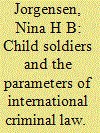

|
|
|
|
|
| Publication |
2012.
|
| Summary/Abstract |
The law on the enlistment, conscription or use of children under the age of 15 to participate actively in hostilities has been addressed in the jurisprudence of the Special Court for Sierra Leone and in the first judgment of the International Criminal Court in the case of Thomas Lubanga Dyilo. This article examines the parameters of the international criminal law relating to child soldiers, focusing on the conduct element of the three modes of committing a child-soldier-related offence. Two main issues are addressed: whether Articles 8(2)(b)(xxvi) and 8(2)(e)(vii) of the 1998 Rome Statute describe two or three separate categories of conduct and whether sexual violence may constitute a form of use in hostilities. These issues are discussed within the framework of the prior evolution of the law and the unfolding practice of the International Criminal Court.
|
|
|
|
|
|
|
|
|
|
|
|
|
|
|
|
| 7 |
ID:
173130
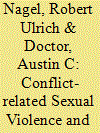

|
|
|
|
|
| Summary/Abstract |
To what extent does sexual violence influence rebel group fragmentation? A substantial body of research explores wartime rape as a cohesion-building mechanism following forced recruitment. However, the relationship between sexual violence and broader organizational structural integrity has not been systematically tested. Our study on the effects of sexual violence on rebel group fragmentation provides this test. We argue that sexual violence increases cohesion at the battalion level but increases the risk of fragmentation of the broader organization because lieutenants are more likely to split from organizations if they are confident that their subordinate battalions are cohesive and will follow them. We test this argument on a global sample of 105 rebel organizations active between 1989 and 2014. The results provide robust support for the argument showing sexual violence increases the probability of fragmentation by a factor of six. This presents a crucial contribution to our understanding of sexual violence and rebel group fragmentation.
|
|
|
|
|
|
|
|
|
|
|
|
|
|
|
|
| 8 |
ID:
186337


|
|
|
|
|
| Summary/Abstract |
“Ending impunity” is often heralded as the key mechanism for stopping rape in war. Yet, little systematic evidence or analyses exist of the relationship between impunity (or lack thereof) and sexual violence. We argue that amnesties signal impunity and permissiveness for sexual violence, which can perpetuate and instigate more sexual violence by rebels. Trials, on the other hand, signal a nonzero probability of punishment, which could have a deterrent effect. Studying all intrastate armed conflicts in the period 1989–2011, we find in line with the impunity signal that amnesties are associated with sexual violence by rebels, but we are not able to demonstrate a deterrent effect of trials. While the study prevents us from conclusively saying that ending impunity would be an effective policy tool to stop sexual violence in war, the association between amnesties and subsequent sexual violence is a testament to the perils of impunity.
|
|
|
|
|
|
|
|
|
|
|
|
|
|
|
|
| 9 |
ID:
172337
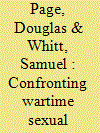

|
|
|
|
|
| Summary/Abstract |
Existing research on conflict-related sexual violence focuses on the motivations of perpetrators and effects on survivors. What remains less clear is how postconflict societies respond to the hardships survivors face. In survey experiments in Bosnia, we examine public support for financial aid, legal aid, and public recognition for survivors. First, we find a persistent ethnocentric view of sexual violence, where respondents are less supportive when the perpetrator is identified as co-ethnic and survivors are perceived as out-groups. Second, respondents are less supportive of male survivors than female survivors, which we attribute to social stigmas surrounding same-gender sexual activity. Consistent with our argument, those who are intolerant of homosexuality are especially averse to providing aid to male survivors. This study points to the long-term challenges survivors face due to ethnic divisions and social stigmatization from sexual violence.
|
|
|
|
|
|
|
|
|
|
|
|
|
|
|
|
| 10 |
ID:
178768
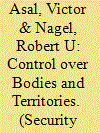

|
|
|
|
|
| Summary/Abstract |
Despite the popular narrative of “rape as a weapon of war,” research shows that only a minority of insurgent groups perpetrate sexual violence in armed conflict. We argue that territorial control is an overlooked factor that can increase the likelihood a group commits sexual violence for two primary reasons: (1) rebel groups seeking to establish control over territory are more likely to commit sexual violence; and (2) groups seeking to maintain territorial control emulate state behavior through violently controlling human, sexual, and reproductive capital, which manifests in forced recruitment and different forms of sexual violence, including rape and sexual slavery. We systematically test this argument using the Sexual Violence in Armed Conflict (SVAC) and the Big Allied and Dangerous Insurgent II (BAADI2) datasets. The results provide robust support for the argument. This constitutes an important addition to our understanding of conflict-related sexual violence and rebel governance.
|
|
|
|
|
|
|
|
|
|
|
|
|
|
|
|
| 11 |
ID:
086650
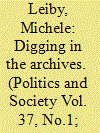

|
|
|
|
|
| Publication |
2009.
|
| Summary/Abstract |
This article explores the methodological obstacles to research on wartime sexual violence and the extent to which they can be overcome with archival research. It discusses issues of concept formation, counting victims of human rights abuse, and coding violations. It compares figures from the Peruvian Truth and Reconciliation Commission's final report, an analysis of the Commission's published materials, and an analysis of the primary documents and finds that (1) the number of reported cases of sexual violence is significantly higher than the 538 cited by the Commission, (2) men were more often the targets of sexual violence than previously thought, and (3) sexual humiliation and sexual torture were common practices during the war
|
|
|
|
|
|
|
|
|
|
|
|
|
|
|
|
| 12 |
ID:
161721
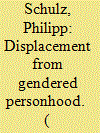

|
|
|
|
|
| Summary/Abstract |
This article empirically deconstructs the gendered effects of sexual violence on male survivors' masculinities in northern Uganda. Throughout the growing literature on the topic, the effects of wartime gender-based violence against men are widely seen as compromising male survivors' masculine identities, commonly framed as ‘emasculation’ by way of ‘feminization’ and/or ‘homo-sexualization’. Yet exactly how such processes unfold from survivors' perspectives remains insufficiently explored, nor has existing scholarship critically engaged with the dominant analytical categories and their associated terminologies. This article seeks to engage with both of these gaps. First, I identify normative and analytical shortcomings of the ‘emasculation’/‘feminization’ paradigm. Drawing on Edström, Dolan and colleagues, I propose an alternative reading to analyse the effects of sexual violence on gender identities. Second, I argue that the impact of sexual violence on masculinities is a layered process, compounded through numerous sexual and gendered harms and perpetuated over time. In northern Uganda, this process is composed of intersecting gendered harms that subordinate male survivors along gendered hierarchies, and that signify survivors' perceived inabilities to provide, protect and procreate—as expected of them by local constructions of hegemonic masculinity. I therefore emphasize that sexual violence against men strikes at multiple levels of what it means to be a man, which is important to understanding and addressing these layered gendered harms in the aftermath of the violations.
|
|
|
|
|
|
|
|
|
|
|
|
|
|
|
|
| 13 |
ID:
141184
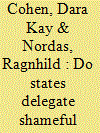

|
|
|
|
|
| Summary/Abstract |
Existing research maintains that governments delegate extreme, gratuitous, or excessively brutal violence to militias. However, analyzing all militias in armed conflicts from 1989 to 2009, we find that this argument does not account for the observed patterns of sexual violence, a form of violence that should be especially likely to be delegated by governments. Instead, we find that states commit sexual violence as a complement to—rather than a substitute for—violence perpetrated by militias. Rather than the logic of delegation, we argue that two characteristics of militia groups increase the probability of perpetrating sexual violence. First, we find that militias that have recruited children are associated with higher levels of sexual violence. This lends support to a socialization hypothesis, in which sexual violence may be used as a tool for building group cohesion. Second, we find that militias that were trained by states are associated with higher levels of sexual violence, which provides evidence for sexual violence as a “practice” of armed groups. These two complementary results suggest that militia-perpetrated sexual violence follows a different logic and is neither the result of delegation nor, perhaps, indiscipline.
|
|
|
|
|
|
|
|
|
|
|
|
|
|
|
|
| 14 |
ID:
169071
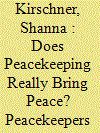

|
|
|
|
|
| Summary/Abstract |
Peacekeeping mitigates killing, but nonlethal violence also influences both positive peace and stability. We evaluate peacekeepers’ effect on one such type of abuse, sexual violence. We posit that peacekeepers raise the cost of abuses and foster institutional and cultural changes that curb violence. We find that missions both reduce the chance of any violence and limit its prevalence; larger deployments and multidimensional missions are more effective. Governments curtail violence more quickly than rebels do in response to military contingents; rebels are especially responsive when missions include large civilian components. These findings contribute to our understanding of peacekeeping in three primary ways: we expand the evaluation of peacekeeping to consider nonlethal violence; we draw attention to mission size, capacity to use force, and civilian-led programming as determinants of effectiveness; and we demonstrate how addressing nonlethal violence requires similar tools as lethal violence but is further enhanced by specific civilian-led initiatives.
|
|
|
|
|
|
|
|
|
|
|
|
|
|
|
|
| 15 |
ID:
095234
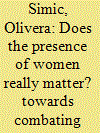

|
|
|
|
|
| Publication |
2010.
|
| Summary/Abstract |
Women are being encouraged to join peacekeeping operations as sexual violence problem-solving forces while simultaneously undertaking a complex role as 'protectors' of local women from local men and male peacekeepers. Since the adoption of Security Council resolution 1325 in 2000, the UN has urged states to deploy more women. Among the implicit assumptions underlying these calls are that an increase in the representation of women in peacekeeping operations (PKOs) will lead to a decrease in the cases of HIV/AIDS, a decline in the number of brothels around peacekeeping bases, and a reduction in the number of babies fathered and abandoned by peacekeepers after their mission comes to an end. Evidence suggests that the presence of women peacekeepers can and does foster a change in male behaviour when women are deployed in PKOs. This article argues, however, that countering abuse should not be a substitute for the more encompassing goal of improving gender balance and equality in PKOs. While there is a need to combat sexual violence in PKOs, the responsibility for prevention should be on troop-contributing countries, which need to exercise accountability and prosecute sexual violence committed by their peacekeepers. Diverting responsibility to women does not address the problem of sexual violence in PKOs, or help eradicate its causes.
|
|
|
|
|
|
|
|
|
|
|
|
|
|
|
|
| 16 |
ID:
180694
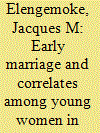

|
|
|
|
|
| Summary/Abstract |
Though several countries have adopted the sexual violence law which criminalizes child marriage, the practice of early marriage persists in Sub-Saharan Africa. This paper examined the socio-economic and demographic determinants of early marriage among young women in four Sub-Saharan African (SSA) countries, namely Niger, Democratic Republic of Congo, Mali and Malawi. Descriptive and multivariate analyses were performed to show that young women without formal education have 1.62, 1.59, 1.55 and 2.08 times more risk of early union than their secondary or higher educated counterparts. The study recommends the implementation of a universal, free and compulsory basic education in SSA countries.
|
|
|
|
|
|
|
|
|
|
|
|
|
|
|
|
| 17 |
ID:
106016
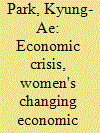

|
|
|
|
|
| Publication |
2011.
|
| Summary/Abstract |
Although many studies have analyzed the gendered impact of economic crisis, few have examined the case of North Korea. This article will explore how North Korea's economic crisis caused changes in women's economic participation. It will also analyze the impact of these new economic roles on the lives of women, and examine the broader implications of these roles for the status of women in North Korea. The North Korean economic crisis changed the pattern of women's economic participation, pulling women out of the formal labor market and driving them into the informal private economic sector. It also forced a number of women to leave their homeland in order to provide support for their own and their families' livelihoods. The new economic roles women have assumed in the wake of the food crisis have affected women's lives in many negative ways, resulting in an increase in their workloads, as well as an increase in the amount of sexual violence and stress of family breakdowns they experience. At the same time, however, these new roles have given women stronger voices in family decision-making matters and allowed them to develop, to some degree, a sense of self-consciousness and awareness of their own rights. Nevertheless, the fact that women have been engaged in new economic activities does not imply that they also have a high likelihood of advancing their socioeconomic status. To the contrary, women's defection from their homeland does not allow them to voice their opinions in matters related to the existing gender inequalities. Moreover, North Korean women are not considered capable of forming a critical mass, as they lack economic, social, political, and organizational resources to collectively voice their discontent. Furthermore, the neo-Confucian tradition of male superiority that is still firmly entrenched in the society is a major barrier that remains to be overcome.
|
|
|
|
|
|
|
|
|
|
|
|
|
|
|
|
| 18 |
ID:
138944
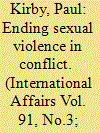

|
|
|
|
|
| Summary/Abstract |
During the past year, the UK Government has become the lead advocate for a perhaps surprising foreign policy goal: ending sexual violence in conflict. The participation of government representatives from more than 120 countries in a London Summit in June 2014 was the clearest manifestation of this project. This article offers an early assessment of the Preventing Sexual Violence Initiative (PSVI) and situates it within the history of global action against sexual and gender-based violence from UN Security Council Resolution 1325 onwards, with a particular focus on three key developments. First, the PSVI has embraced the already common understanding of rape as a ‘weapon of war’, and has stressed the importance of military training and accountability. This has exposed the tensions within global policy between a focus on all forms of sexual violence (including intimate partner violence in and out of conflict situations) on the one hand, and war zone activities on the other. Second, the Initiative has placed great emphasis on ending impunity, which implicates it in ongoing debates about the role of international and local justice as an effective response to atrocity. Third, men and boys have been foregrounded as ignored victims of sexual and gender-based violence. The PSVI has been crucial to that recognition, but faces significant challenges in operationalizing its commitment and in avoiding damage to existing programmes to end violence against women and girls. The success of the Initiative will depend on its ability to navigate these challenges in multiple arenas of global politics.
|
|
|
|
|
|
|
|
|
|
|
|
|
|
|
|
| 19 |
ID:
157780


|
|
|
|
|
| Summary/Abstract |
Many studies have looked into domestic violence but very few have considered women’s knowledge and perception about their rights. This study aims to examine the main sociocultural factors behind domestic violence against women with an emphasis on the power of the knowledge and perception of the women about their international and constitutional rights. Quantitative data collected in 2015 in the regions of East and Southwest Burkina Faso is used in this paper. Multivariate logistic regression is implemented to take into consideration the net effects of each factor when controlling the effects of other covariates. Results of this paper can be used to implement actions against domestic violence in the zone of intervention of the Program of Sexual Health and Human Rights project.
|
|
|
|
|
|
|
|
|
|
|
|
|
|
|
|
| 20 |
ID:
185258
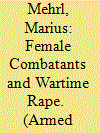

|
|
|
|
|
| Summary/Abstract |
Whereas existing research posits that the presence of female fighters in armed groups decreases their propensity for wartime rape, one recent study tests this claim quantitatively and is unable to detect a statistically significant effect. This leads the author to conclude that female combatants do not decrease rape. Using that study’s original data, this article reexamines the evidence for the relationship between female rebel combatants and wartime sexual violence. Replications of the original models suggest that they make strong functional form assumptions regarding numerous independent variables and time dependence and that relaxing them results in substantively different findings. Namely, women’s participation in armed groups decreases groups’ use of wartime rape. In support of Loken’s organizational theory of rape, results also suggest that this effect is moderated by group norms. These findings contribute to the literature on female participation in rebel groups and beyond.
|
|
|
|
|
|
|
|
|
|
|
|
|
|
|
|
|
|
|
|
|